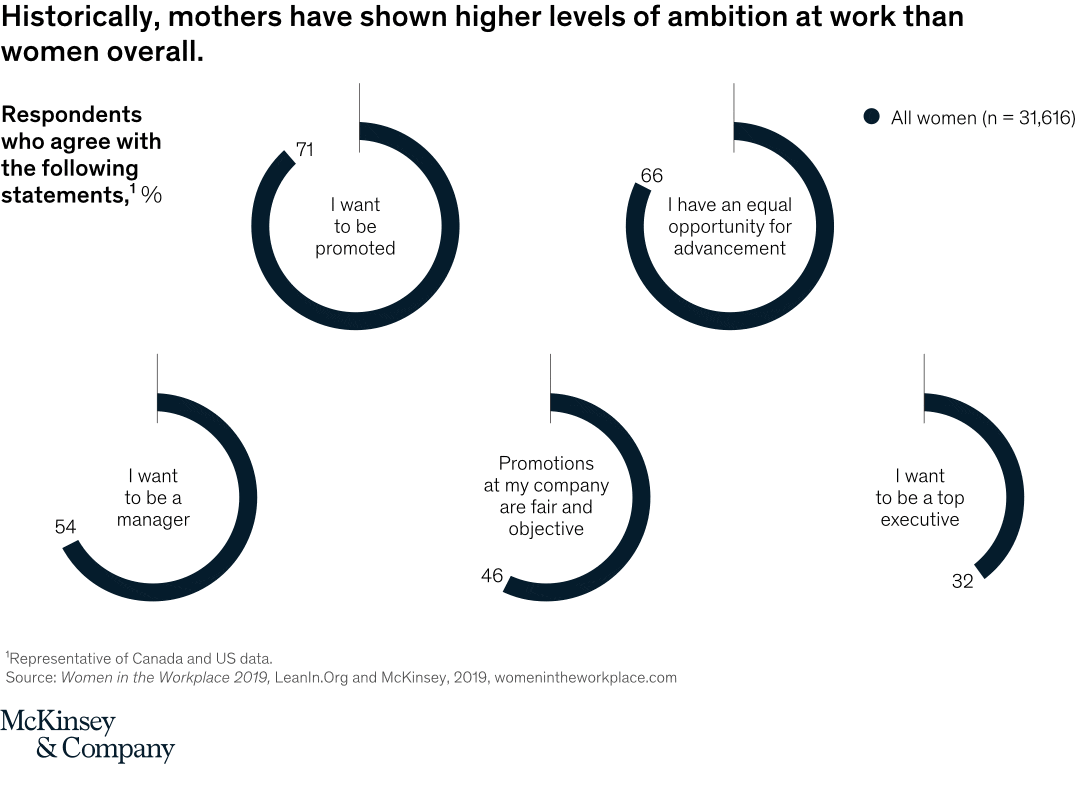
My mother loved being a mom. She used to say, “Every day is mother’s day!” But for today’s moms, particularly those trying to balance work and life, it hasn’t been easy. And the pandemic hasn’t helped an already challenging situation.
The pandemic’s impact on women, particularly working moms…
A recent article from McKinsey highlighted just how hard it has been for working moms. First there’s the kids, then there is aging parents, then saving some time for relationships, housework, cooking, homeschooling…and did I mention getting their other work done at their jobs. It’s not just a matter of addressing what is the right thing to do; companies with more female executives and more diversity have been more likely to outperform those with fewer women in those roles.
Have no doubt about it, working moms have as much or more ambition as women who are not moms.

But since the pandemic, one third of working moms have considered either lowering their work ambitions or simply dropping out. We don’t have to consider this just for the sake of the moms, which we should, but also because the cost of replacing an employee is huge. And businesses lose all that woman’s wisdom and talent for an unknown quality replacement. In the five years leading up to the pandemic, the number of women in senior-vice-president positions increased from 23 to 28 percent, and in the C-suite from 17 to 21 percent, according to McKinsey. Now we are at risk of seeing that trend reverse.
And then there’s the mental health portion…
We’ve all lived through this pandemic. It should come as no surprise that a 2020 survey by Kaiser Family Foundation found that 45 percent of Americans felt that the pandemic harmed their mental health. I’m surprised the impact wasn’t higher as everyone I know personally and professionally has felt stressed at some level. Globally, women have been hit the hardest: in both advanced and developing countries, three fourths of mothers versus two thirds of fathers are struggling with mental health concerns.
It was even more challenging for at-home remote working moms versus dads. At home there is no place for moms to go for a time out. And for those who had parents in elder care, assisted living or nursing homes, the task was even greater. Making sure they had their medications, their personal toiletries, got to their doctors visits or had facetime or zoom available, had some sense of not feeling isolated or abandoned. I didn’t see my own mom for a year as she lived in assisted living and the social functions were cut off to decrease spread of infection. Visitation wasn’t allowed and what do you say the closing comment that was certain to be asked before hanging up at each call…”When are you coming to see me?”
The issue of women in the workplace needs to be addressed. As I said earlier, if you don’t want to address it because it is the right thing to do, address it because it is good for your business.

What can you do?
Improve childcare programs. Increase childcare support and provide emergency or subsidized childcare resources , tutoring programs for school-aged children, or other programs. In the best of all worlds, these policies would evolve into long-term changes.
Tailor solutions for diverse needs. Black, Latina and Asian women may have different needs than white women. Addressing these issues will optimize the outcomes.
Get flexible. When my first child was born, we asked our pediatrician, who was also my father-in-law, when things would get back to normal. He responded, “Things are normal; normal has changed.” Businesses would be wise to recognize that there is a new normal. In one survey, only 8 percent want to return fully on-site.
Be more aware. Realize that at least 15% of women in the workforce are dealing with the symptoms of menopause, and those issues can dramatically add to the challenges women are facing. Women in midlife are also more likely dealing with aging parents and “older” children issues. Even without a pandemic, the single issue of untreated hot flashes results in 6 additional doctors visits per year compared to women with treated hot flashes. Creating a workplace of inclusion and removing the taboo of menopause could have a huge impact on this demographic, as could program that address the issues associated with menopause. Visit MenopauseQuiz.com to see how much your symptoms are affecting you.
Rethink Rehiring: For women who have had to drop out for the reasons above, avoid typical negative judgements about their gap years. Provide an on ramp with job training for skills that can be learned at work, and provide mentorships that allow women who have been displaced from the workplace to regain their footing.
In summary…
There is a huge volume of women workforce talent that is currently or will soon be ready to reenter the workforce. Businesses have the ability to help enable them. It’s not a hand out; it’s a hand extended. And the impact of improving women’s lot in the workplace may be the very thing that propels your business to the next level, or prevents it from being surpassed by a competitor who realized what’s good for women in the workforce is also good for business.



